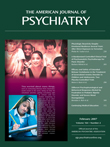Language is the neglected child in psychiatric research. We depend upon language for every aspect of psychiatric diagnosis and treatment, yet our understanding of how words work in the clinical setting has advanced little scientifically beyond Andreasen’s seminal articles on “thought, language, and communication disorders” (1) or the classic study of therapeutic discourse by Labov and Fanshel (2), both from the 1970s. Thus, the appearance of a book titled Language in Psychiatry: A Handbook of Clinical Practice seems highly promising. Adding to the appeal is that the author, Jonathan Fine, is neither a psychiatrist nor a linguist, but a teacher of English at Bar-Ilan University—a background that could potentially limit his understanding of either field, but that alternatively might stimulate a fresh, cross-disciplinary approach.
He begins with an extended description of the theory of “systemic functional linguistics.” It focuses on how speakers use the resources of language to make meaning. “Meaning” is more than semantic: it refers also to the quality of relatedness and the social identity that is created through the infinite variety of words, tone, and gestures that we employ when speaking with others. Psychiatric disorders display “odd sounding language at two levels: odd meanings and odd wordings of meanings” (p. 29).
Fine aims to demonstrate the distinct linguistic features of many different psychiatric disorders. Moreover, he aims to suggest how the speech difficulties that are characteristic of each disorder relate to its behavioral manifestations, how differences in meaning may aggregate into diagnostic patterns of “family resemblance,” and how “the phenomena described directly and in detail may reflect underlying mechanisms of pathology” (p. 9).
In schizophrenia, to pick only one analytical example from the hundreds in the book, he provides a sample of dialogue to illustrate the “free flow of speech from topic to topic or through other changes without ... boundary markers” (p. 228). This relates more broadly to the social disconnection and idiosyncratic sense of reality of the patient with schizophrenia: “[f]ailure to signal boundaries at the level of language ... also contributes to the failure to signal boundaries at the level of social process and at the ideational and interpersonal levels” (p. 228). The quality of being “disconnected from the context” helps us to understand “why the speaker does not accomplish the social processes of everyday life” (p. 228).
Given that Fine is not a psychiatrist, it would be easy to find flaw with some of his psychiatric formulations and also to suggest that he is saying nothing new about psychopathology. But that would largely miss the point. As he puts it:
[O]ne comment indicating a clear, bizarre hallucination forms an immediate impression of schizophrenia, whereas it may take ten to 15 percent of nominals to be unclear to form an impression of disorganized speech. The clinician’s intuitive judgments and the lay community’s impression of bizarre behaviour use an unknown combination of these specific linguistic markers that are nevertheless quite reliable in identifying schizophrenia (p. 235).
Fine proposes to supplement clinical intuition with a catalogue of the rich and distinctive language variations that give empirical grounding to our diagnostic ideas.
There are at least two serious problems with this book. One is the author"s arbitrary and often confusing manner of presenting verbal material. He has no systematic method of transcription; sometimes he alters verbal material or adds to it with italics or bracketed explanations that are not explained, and sometimes he takes “normal” speech and alters it to illustrate how it would presumably sound if it were distorted by the psychopathology under discussion. This leaves the reader unclear about what his material has actually shown versus what is hypothetical.
Another major problem, particularly in view of his using terms above like “quite reliable,” is that he presents no systematic data. Passages of discourse are proffered individually with no attempt to present aggregate findings or even to show a pattern of verbal behavior across different interviews. Consequently, what Fine presents is not so much conclusions as speculations about how language might both reflect and contribute to psychiatric disorders if systemic functional linguistic theory were to apply.
Despite these lapses, Fine can surely be credited with having aimed too high rather than too low. His goal is a comprehensive program to link a linguistic theory with psychopathology—a fresh, cross-disciplinary aim indeed.

